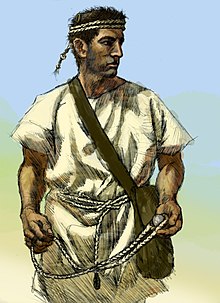| This article includes a list of references, related reading, or external links, but its sources remain unclear because it lacks inline citations. Please help improve this article by introducing more precise citations. (February 2024) (Learn how and when to remove this message) |

The Balearic slingers, indigenous to the Balearic Islands, were warriors from ancient times famed for their mastery in the art of using the sling. They also served as mercenaries for both Carthaginian and Roman forces, particularly during the post-Talayotic era.
They played a role in the wars against the Greeks in Sicily and the Second Punic War, including the Battle of Baecula. Later, they served as light infantry auxiliaries in various battles, including Julius Caesar's legions in the Gallic Wars. Initially recruited voluntarily, conflicts with the Balearic populations arose during the final phase of the Punic Wars, leading to forced conscriptions, especially in Menorca.
History
Carthaginian army
They are first mentioned in the mid-4th century BCE in Sardinia and during the conquest of Selinunte (409 BCE) in the context of the Second Sicilian War. Diodorus Siculus places them among Carthaginian fighters during the capture of Agrigento and, already in the Third Sicilian War, in the Battle of Ecnomus (310 BCE), under the command of Hamilcar, son of Gisco.
According to chroniclers, Hannibal had approximately 2000 Balearic slingers, positioned at the forefront of his army during the early stages of the Italian campaign, responsible for initiating the fight to harass the Romans. It is noteworthy that the Balearic slinger contingents were explicitly mentioned in Hannibal's troop distribution before leaving command of the Carthaginian territory in the Iberian Peninsula to his brother Hasdrubal, to whom he entrusted 500 Balearic slingers. Hannibal attached great importance to these troops and protected them throughout the campaign as irreplaceable soldiers. The reason for their military effectiveness lay in the greater range and precision of the sling compared to the bow.
Roman army
After the Roman conquest of the Balearic Islands, historical sources again mention the slingers, now integrated into the Roman army. Gaius Sallustius informs us of Balearic slingers among Roman troops fighting in Numidia against King Jugurtha (111–105 BCE). Caesar mentions Balearic slingers as fighters in the Gallic Wars around 56 BCE, fighting alongside other elite troops such as Numidian cavalry and Cretan archers.
In classical sources
The Balearic slingers are documented in the works of Strabo, Diodorus Siculus, Florus, Livy, Polybius, and Zonaras. Virgil mentions them in The Georgics, and Ovid in Metamorphoses. In the modern era, Miquel Costa i Llobera mentioned them in several of his odes concerning the traditions and culture of Mallorca.
Equipment and weapon

They were equipped with a goat skin shield and an iron-tipped or fire-hardened javelin for close combat. In battle, they used three slings: one was larger for longer shots, worn around the waist; another of medium size was held in the hand; and a smaller one for close-range shots, worn on the head. The projectile could be launched in different ways, but they essentially had three types of shots (one for each sling). The slings were (and still are) made from cord, with six segments of cord, resembling a braid. The projectiles, called glandes, were launched after three spins of their slings and could be made of stone, terracotta, or lead. They could weigh up to 500 g (1.1 lb), and their effects on enemy troops were powerful.
References
- Conselleria de Cultura del Govern Balear (1992). La Prehistòria de les Illes de la Mediterrània Occidental (in Catalan). Palma de Mallorca.
{{cite book}}: CS1 maint: location missing publisher (link) - Rosselló Bordoy, Guillem (1979). La cultura talayótica en Mallorca (in Spanish). Palma de Mallorca: Cort. ISBN 9788485049295.
- Nadal Cañellas, Joan (2000). Els foners balears (in Catalan). Palma de Mallorca: Grup Serra. OCLC 777179224.
- Blázquez, José María; Alvar Ezquerra, Jaime; Wagner, Carlos González (1999). Fenicios y cartagineses en el Mediterráneo (in Spanish). Madrid: Cátedra. ISBN 9788437617312.